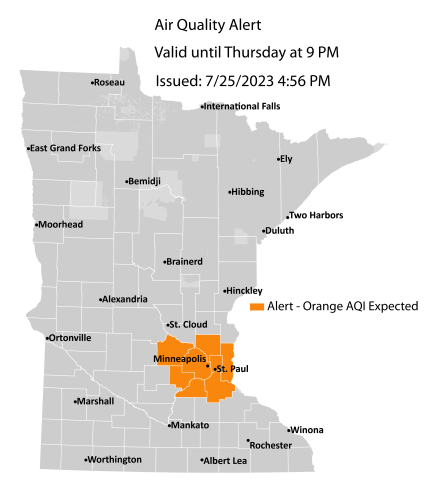
Air quality is expected to reach the orange AQI category in the Twin Cities, which is unhealthy for sensitive groups.
The Minnesota Pollution Control Agency (MPCA) has issued an air quality alert for the Twin Cities, effective from noon on Tuesday, July 25, through 9 p.m. on Thursday, July 27. The affected area includes the Twin Cities metropolitan area, and the tribal nation of Prairie Island.
The air quality alert in northern Minn. for wildfire smoke has been allowed to expire.
In the Twin Cities, ground-level ozone is expected to be high during the afternoon hours on Tuesday, Wednesday, and Thursday. Sunny skies, warm temperatures, and low humidity will create an environment favorable for two types of pollutants (volatile organic compounds and nitrogen oxides) to react in the air to produce ground-level ozone. Ozone will be highest during the afternoon and early evening hours when sunshine is most abundant, and temperatures are highest. Ozone will be low in the morning, late evening, and overnight.
Ozone levels are expected to reach the orange air quality index (AQI) category, a level considered unhealthy for sensitive groups, across central and southern Minn. The health impacts of air quality are exacerbated by extreme heat. Sensitive groups, such as people with lung disease (including asthma), heart disease, children and older adults, and people who are active outdoors, should take extra precautions and avoid prolonged or heavy outdoor exertion. The general public should consider timing outdoor exertion during the morning hours when both temperatures and ozone levels are the lowest.
The alert area includes the Twin Cities and the tribal nation of Prairie Island. In the orange ozone alert area, sensitive groups should limit prolonged or heavy exertion and time spent outdoors during the afternoon and early evening.